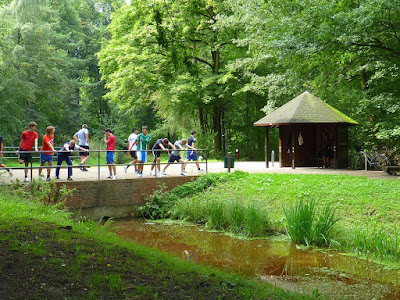 |
| A group of joggers warming up at a meeting point in the Stadtwald, a forested park in Bremen, Germany |
Urban parks brighten
cityscapes. They originate as
designed gardens or
reclaimed city parcels and sometimes they are simply left-over stripes and spots of a once
natural landscape. Many parks allow on-trail and off-trail use.
On-trail: footpaths, walkways and promenades present themselves for morning or evening runs as well as walks and strolls. Often, a short-cut through a park is the fastest way for the daily commute by bike.
Off trail: park greens invite to stretch out or play—the flute, frisbee or football, whatever the park space provides for and inventing visitors may come up with.
Urban parks are meet-up places. On beautiful days, a small city park—even the planted square or triangle at a street corner—is a great place for a lunch break, while a larger park always becomes a recreation hot spot. For example, the
Stadtwald in the city of
Bremen, Germany, is a popular place for jogging (top picture), outdoor gymnastics and segway tourings. The
Stadtwald—literally meaning
city forest—is too small to be considered a wilderness forest. But located between Bremen's
Bürgerpark and University quarters, the wider
Stadtwald area provides an extensive trail network attracting young and old to leave office or home for a work-out among trees and alongside waterways.
 |
| Boston Common, Boston, Massachusetts |
Urban parks are neighborhoods. City parks are public backyards used for many different purposes. In his exploration of urban parks around the world, Ken Otterbourg writes that urban parks are not a substitue for the enormous and often remote parks that protect the most majestic forests, mountains and canyons, we like to visit via distance traveling [1]. They are retreats from the duties and curtailments that modern civilization brings with it.
Boston Common (picture above), the oldest park in the United States, is such a place to briefly escape and hang out or recreate between downtown and Beacon Hill. In the past, this park has seen cattle grazing, public hanging, camping of the British troops and deliverance of political speeches. Today, it is the anchor of the
Emerald Necklace, a chain of parks winding through and connecting
Boston neighborhoods [2].
 |
| Sculptured ways near Groningen's central station |
Urban parks are connectors. Bremen's
Stadtwald/
Bürgerpark pairing and Boston's
Emerald Necklace are just two examples of how urban parks interconnect city districts and their people. Another is the
Davis-Covell Greenbelt in the city of
Davis, California, featuring a loop trail with charming bronze sculptures and nature side walks. In some locations, parks shrink to connectors, which are vital in providing walking, hiking and bicycling options by avoiding frequent encountering and crossing of motorized routes. Even when barely any trees are around, such ways promote relaxation, calm and an overall easier-going life style.
For example, a broad walk & bike way connects the central station in the Dutch city of
Groningen with other parts of that city (picture above).
Elevated walkways such as those in
Hamburg's Speicherstadt are smart and scenic solutions to pedestrian flow, heightening travelers three-dimensional city experience.
A straight promenade under trees, which connects the
Idlewood Park in
Reno, Nevada, with
Wingfield Park island, squeezes in between the Truckee River and Riverside Drive (picture below), adding an illusion of infinity to occasionally confining city life.
Ask the park designer in you what park features are special about your city and what you would improve? In some years your ideas may have become reality.
 |
| Snowy Truckee River walk in Reno |
From urban parks to green and enlightened cities. The future of urban parks looks bright. As cities are turning from mere places of commerce and work into inspiringly designed living & learning centers and attractive playgrounds competing for visitors, cities grow into
urban parkscapes with more and more non-motorized tracks to enhance outdoor time for active and adventuring urbanites.
Urbi et urbi!
Keywords:
recreation,
cityscaping,
urban planning,
urbanistics,
urban geography.
References
[1] Ken Otterbourg:
Urban Parks.
National Geographic April
2016,
229 (4), 86-107.
[2]
Boston Common:
http://www.cityofboston.gov/freedomtrail/bostoncommon.asp.


















1 comment:
Urban parks truly connect people and places, offering great escape within cities. Though some lack upkeep or feel underused, they still hold big potential. Planning like in paulding parks and recreation can really help parks thrive for all ages and activities.
Post a Comment